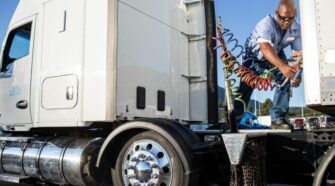

Financing a Semi-Truck
Are you considering a career as an Owner Operator truck driver or thinking about taking steps to buy a semi-truck? No matter what your situation is, you need the right information to find and invest in the truck that best meets your needs. As an Owner Operator, it is your goal to run a profitable business. Therefore, setting your purchase budget, and understanding the best way to pay for a new or used semi-truck is very important. The price tag for a new Freightliner for example can easily run over $125,000 or more, depending on the truck type and the options you select.
One of the biggest mistakes first-time semi-truck buyers make is thinking the loan process will be just like getting a mortgage or financing for an auto loan. Banks look at a truck purchase, especially a first truck, as a very risky venture. Remember that you’re not purchasing that brand new 18-wheeler for your own personal transportation, .rather you’re buying it as a tool to earn income with, like a carpenter buys a hammer. A really big, really expensive hammer that requires specialized financing to complete the sale. As a result, lenders typically have more stringent requirements when qualifying you for a commercial vehicle loan.
- A higher down payment is typically expected compared to an auto loan. Some purchases can be made with 0% down, depending on your credit, the age of the truck, and various other factors. If you have not-so-great or low credit, be prepared to put down 15%, 20%, 30% or more depending on your situation.
- Interest rates are also different from what you might see with an auto loan — between 6% and 10% is common, but can be higher depending on your credit situation.
You’ll want a lender that’s a good fit for your particular business and the type of loan you’re applying for. For semi-truck loans, lenders typically like to see a score of at least 600, while some require 660 or higher. Exact qualifications will vary by lender. As with other loans, a good credit score can help you win approval and get more favorable terms. But your credit score alone isn’t enough. Your goal is to eliminate as much risk as possible in the eyes of the lender.
- If you can demonstrate driving experience (most places look for 2 years+) and an established revenue stream to go along with a good credit score, you boost your case even more.
- If your credit score is low the lender may require a cosigner on your loan.
- It also helps to have different kinds of credit, such as installment credit in which you make fixed payments at regular intervals. Examples would include a mortgage or car loan.
- Having a credit history of at least seven to 10 years is also ideal. This can be a challenge for drivers who are from outside of the United States.
For those with little to no experience, a low credit score, or little to no credit, it can be challenging to get financing for a semi-truck. It’s even more difficult to launch a trucking business without a truck. So how do you solve this dilemma? The fact is, most new owner-operators don’t have the cash to buy a truck, and many simply lack the credentials to get approved for a loan. This is where commercial truck leasing can be an attractive option. If you go the leasing route, look for a truck in good condition that is less than 10 years old, with less than 700,000 miles. If you can spend the first few years gaining valuable experience, managing your costs wisely, and building up your cash reserves and your reputation, you’ll be in a much better position to make that first semi-truck purchase.
Having your documentation ready establishes credibility with your lender. It signals that you’re ready for a large purchase. Here are some of the items you’ll want to have prepared when you apply for your loan.
- Current business documents. As noted earlier, have proof of LLC or corporate registration handy, along with all required business licenses and certifications. At minimum, you’ll also want to have at least 3 months of bank statements.
- Driver credentials. The lender will want to see your CDL, and proof of how long you have been driving. Your tax returns can usually provide this proof. If you have them, you should also be able to provide your US Department of Transportation number, and your Motor Carrier Number.
- Tax returns. Most times tax returns won’t be required for an owner-operator to purchase a single truck. But it’s a good idea to have at least two year’s worth of tax returns. This will provide important data to your lender including revenue, expenses, and operating statements. It also verifies your owner-operator status.
- Proof of insurance. Most lenders will require proof of insurance before they will fund the deal. You can get pre-approval for a loan without insurance, but you won’t get the actual funding until you secure an appropriate insurance policy. What kind of insurance do you need? For one thing, you need protection for the truck itself and the cargo you’re carrying. If you are operating a fleet of trucks, you’ll also need worker’s compensation to protect your employees and general liability to protect your business in case of a lawsuit. Check out our blog post for more information on Commercial Trucking Insurance.
The truck itself serves as collateral on the loan. That means in addition to your personal credit, and your trucking experience, your lender will look at the condition and quality of the truck when deciding whether to approve you for financing.
- It’s easier to get financing for a fleet of trucks than for a single truck. If you have 10 trucks and one breaks down, that’s a 10% reduction in your business until you get it repaired or replaced. If you have just one truck and it breaks down, that’s 100% of your business.
- As with leasing, look for a truck that’s less than 10 years old and with less than 700,000 miles. Older trucks break down more frequently, which means they earn less and cost more to own. Most finance companies have restrictions on the maximum miles on a truck they will finance.
You will need to figure out how much you can afford for your down payment, your monthly installments, and insurance, as well as the routine cost of ownership. At the end of the day, you need to make sure not to take on more cost than you can handle to remain profitable.
Now that you are armed with knowledge of the commercial truck financing process, you’re ready to take the next steps towards buying your first truck!
Search our site
Related posts


Illinois Trucking Association Golf Outing 2023

Where to Buy a Kenworth Truck From MHC


